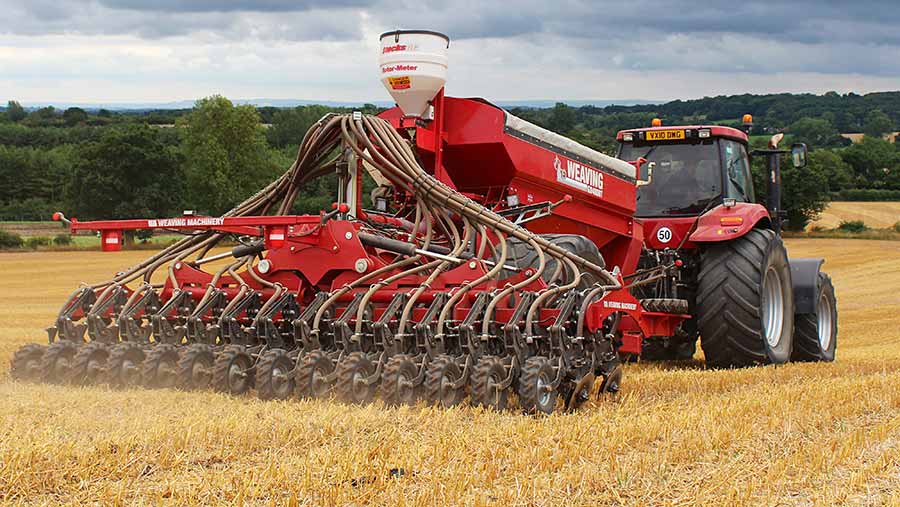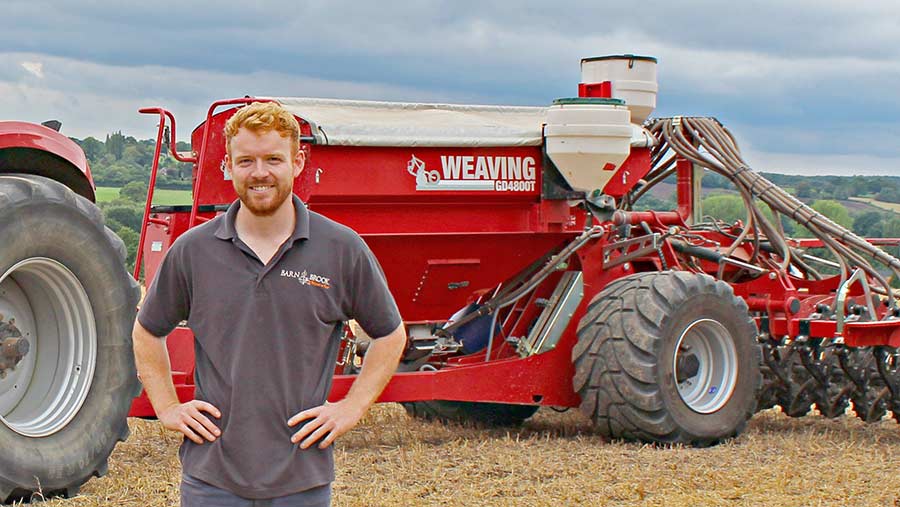Driver’s View: Henry Muntz’s Weaving GD drill

Henry Muntz reveals how his Weaving GD no-till drill has performed across his farm of Warwickshire clay loam.
What drill are you using?
We’ve got a 4.8m trailed Weaving GD that arrived on the farm ready for autumn planting in 2016.
It has an angled double disc for cutting the slot and planting the seed and a rubber tyre packer for closing the ground afterwards.
The main hopper will comfortably hold 2t of wheat and it came with a Stocks applicator that we use to put ferric phosphate slug pellets in with the seed.
Farm facts
Farm address: Mows Hill Farm, Tanworth in Arden, Warwickshire
Acreage and soil type: 550ha (385ha arable) of mainly Warwickshire clay loam with some red marl
Crops grown: Wheat, oilseed rape, spring oats and linseed
A second no-fills Delimbe seeder unit was also added so that we can drill cover crop mixes with a variety of seed sizes such as phacelia, buckwheat, vetch, oats, mustard and linseed.
We drill using Trimble-based auto-steer and we always work at an angle to our tramlines.
See also: Driver’s view: Tom Hounsfield’s Sumo DD drill
Why did you change to a no-till drill?
We’d used a 6m Vaderstad Rapid for years and it had got to the stage where we needed to replace it or give it an expensive overhaul.
That was a good excuse to have a look at other options, so we looked into the Cross Slot and asked someone to plant a trial field for us. It looked poor to start with, but ended up being one of our best crops.
That’s when we decided to give no-till a go.
We couldn’t justify the price of the Cross Slot and the power needed to pull it so after a bit of shopping around we decided to try a Weaving GD.

How does it work?
The coulter assembly is has a double disc mounted at a 25deg angle that cuts a slot and plants the seed. The whole unit pivots so it’s got a bit of give for going round slight corners – we reverse into most though.
The larger outer disc cuts the main slice in the soil, while the smaller inner disc forms an opening for the seed to be placed. Finally, the soil is firmed down onto the seed by a single press wheel.
Drilling depth is controlled by the rear press wheel and is adjusted using a pin-and-hole arrangement. There’s also a hydraulic pressure system for each coulter.
Weaving GD 4800T
- Year 2016
- Width 4.8m
- Spacing 167 cm
- Coulters Angled disc
- Max coulter pressure 200kg
- Hopper 2,500-litre
- Metering control RDS
- Power used 335hp
- Drilling speed 8 to 12kph
- Output 40ha per day
- Price £56,600
How has it performed?
We’ve drilled about 800ha so far and its performance has been excellent. We’ve got some pretty heavy clay ground in places and it’s actually given some of its best results on these.
Beans were the only crop that really struggled with the system, probably as the ground was too hard for them to get their roots down properly.
One big bonus is the fact it gets the crop in the ground much more quickly and cheaply than we could with the Vaderstad Rapid.
At the moment we’re still using the same 330hp Case Magnum 335 – which is far more powerful than we need – but because we’re only running it at 1,200rpm, fuel use is down to 2.3 to 3-litres/ha.
The drill is also allowing us to experiment with growing cover crops and catch crops, which are helping us to build fertility and reduce blackgrass pressure.
On top of that, we’re planning to put some tillage radish in to lift some of the compacted areas without deep loosening.
We’ve had very few problems with it mechanically, other than a faulty alarm on the RDS control box and a ram seal on the coulter pressure ram.

What could be improved?
One of the worst things is how it handles on the road. It’s got a sort of numb feel to it and it transfers weight on and off the rear of the tractor so you end up bouncing along like a nodding donkey.
Next year we might get around the problem by fitting a Scharmuller ball-and-spoon hitch so there’s a bit more articulation.
It also tends to hang down when going across slopes, and although you can push the wheels out wider to counteract this, it’s not particularly effective.
We also don’t like the fact that it dribbles seed when you lift out on the headland. This is largely due to the fact that the coulters are so much further back than the metering unit.
Preventing the press wheels from getting punctures would be another improvement. I’m not sure if solid wheels would do the job properly, but they sound like a good idea to me.
Likes
- Simple and low maintenance
- Ability to drill through thick cover crops
- Everything is accessible and easy to calibrate
- Low soil disturbance
Gripes
- Horrible on the road
- Dribbles out seed on headland
- Press wheel punctures
- Paint isn’t brilliant

